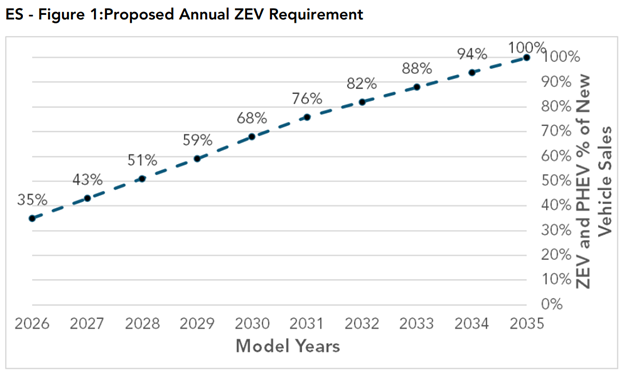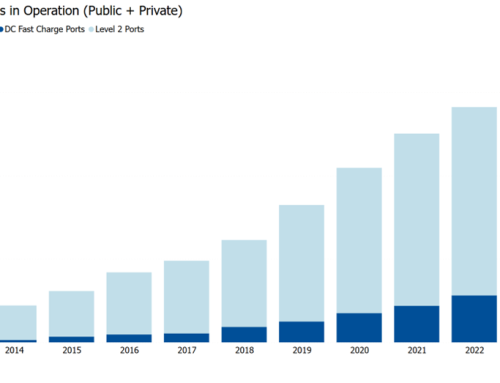
Source: CARB proposed rules
The Advanced Clean Cars II proposed rules were released on April 12. Advanced Clean Cars brings together two key programs – the ZEV Program and the passenger vehicle emission standards. Given this is an EV crowd, let’s focus on the ZEV program.
The proposed rules have California at 100 percent zero-emission vehicle and plug-in hybrid emission vehicle sales by 2035. This is consequential not just for California but also for the 14 states that have adopted the ZEV Program in California’s first Advanced Clean Cars rules and may again follow suit.
The proposed rules are 229 pages, here’s a flyover.
Firstly, what is the problem the rules are designed to address?
Air pollution and climate change. Vehicle emissions are the cause of 80 percent of ozone precursor emissions (e.g. NOx and VOCs) and approximately 50 percent of California’s GHG emissions. The state has some of the poorest air pollution quality in the country and, “The South Coast and San Joaquin Valley air basins are the only two regions in the country classified as ‘Extreme’—the worst category—for nonattainment of the federal ozone standard of 70 parts per billion.” The regulations are also designed to help the state to achieve its goal of carbon neutrality by 2045.
What’s the background?
Advanced Clean Cars (ACC) II follows on from Advanced Clean Cars I, the first clean cars regulations signed in 2012. ACC I covers model year 2015 through model year 2025.
The ZEV Program in Advanced Clean Cars II requires automakers in California to sell an increasing proportion of zero emissions vehicles.
Given that the state’s clean air rules predated federal rules, California has an exemption under the Federal Clean Air Act from “federal preemption of state motor vehicle emission standards” to regulate vehicle emissions. States may choose to adopt that standard (Section 177 states) or the federal standard.
What has happened with Advanced Clean Cars II to date?
The proposed new rules were released on April 12, 2022. The ZEV Program would see that zero emission and plug in hybrid vehicle sales grow from 35 percent of the market in model year 2026 to 100 percent in 2035. Zero emissions vehicles include both electric and hydrogen fuel cell vehicles.
How do these rules work?
The rules work through a compliance credit system where manufacturers are obligated to surrender ZEV credits based on how many vehicles they sell and the annual ZEV target for that year. Manufacturers generate credits by selling qualified zero emission vehicles, based on the statutory credit generation formula. Credits are tradable and bankable, meaning that a manufacturer that over-complies with the standard can sell their left-over credits to other manufacturers or save them for compliance in future years.
At this stage, 17 manufacturers will need to comply, making up 98 percent of all sales for light duty vehicles and light trucks in the state.
What are the major changes in the new ZEV program?
Aside from defining new ZEV targets past 2026, the most significant change in the new regulations is in how credits are generated. In the past, the credit generation formula allowed for manufacturers to generate up to four credits with a single BEV or FCEV sale and up to 1.1 credits from a PHEV sale. In the proposed rule, credits are capped at 1, except for limited additional credits earnable through selling: low-cost vehicles, discounted vehicles in disadvantaged communities, and off lease vehicles through income restricted programs. This means that to comply with ZEV targets automakers will have to sell substantially more ZEVs than under past regulation.
What are the new minimum requirements for vehicles?
One change is that EVs range will increase from a 50-mile UDDS range to 200 miles as the minimum (150-mile real world range). In addition, CARB is adding minimum requirements for battery longevity and requiring all EVs to be sold with an included level 2 EVSE (charger that can plug into a common dryer outlet).
What about the impact on environmental justice communities?
Broadly, the Advanced Clean Cars II notes a suite of benefits for environmental justice communities including credits for “community car share programs, producing affordable ZEVs, and keeping used vehicles in California to support CARB’s complementary equity incentive programs”. It also notes that the benefits of the transition will accrue to all communities – lower total cost of ownership and air pollution benefits.
Does this mean that Section 177 states will also be phasing out all ICE vehicles by 2035?
So-called “Section 177” states follow the ZEV Program. There are 14 Section 177 states following the ZEV Program well as Delaware, New Mexico and DC that are in some stage of adopting the standards. States would need to adopt the Advanced Clean Cars II and Massachusetts for instance has already indicated it will adopt the standards by the end of 2022.
So gas cars can no longer be sold in 2035?
Not exactly, the rules only apply to new vehicle sales, so existing gasoline vehicles can still be resold. In addition, up to 20% of ZEV credits can be generated by selling long-range plug-in hybrids, which will still use gasoline on longer trips or if infrequently charged.
What has been the reception to the proposed rules?
The rules have been criticized by some green groups including the Center for Biological Diversity for not being strong enough. They say the state should aim for 2030 for 100 percent EV sales. Also Don Anair from the Union of Concerned Scientists told Utility Dive that the proposed rules “should serve as a floor rather than a ceiling.” Other green groups, like EDF, called it a “significant step”.
Meanwhile the Alliance for Auto Innovators said this target would be “extremely challenging” to achieve for automakers.
What are the costs?
The Standardized Regulatory Impact Assessment (SRIA) estimated that between 2026 and 2040 the rules will cost automakers $30.2 billion and will result in 39,800 net job losses.
What are the benefits?
The Standardized Regulatory Impact Assessment (SRIA) also estimated more than $80 billion in net cost savings due to lower total costs of ownership and considerable health benefits. There will also be significant greenhouse gas emissions reductions as captured in analysis from the Environmental Defense Fund.
What next?
There is a 45-day public comment period open now. Then, the Board Hearing date for the rules is June 9, 2022. CARB expects a second hearing in August 2022 at which time the board will vote on the rules.


